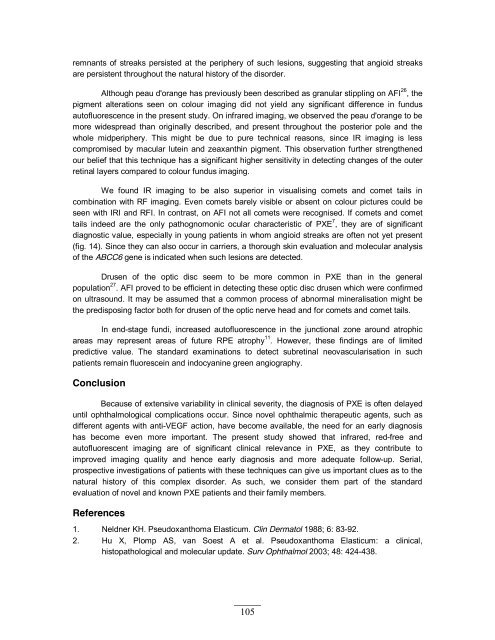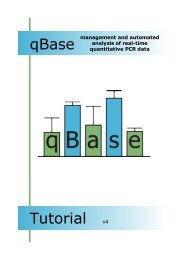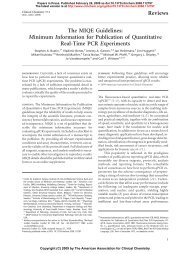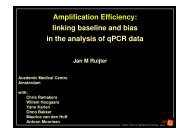This thesis is dedicated to my grandparents
This thesis is dedicated to my grandparents
This thesis is dedicated to my grandparents
Create successful ePaper yourself
Turn your PDF publications into a flip-book with our unique Google optimized e-Paper software.
emnants of streaks pers<strong>is</strong>ted at the periphery of such lesions, suggesting that angioid streaks<br />
are pers<strong>is</strong>tent throughout the natural h<strong>is</strong><strong>to</strong>ry of the d<strong>is</strong>order.<br />
Although peau d'orange has previously been described as granular stippling on AFI 26 , the<br />
pigment alterations seen on colour imaging did not yield any significant difference in fundus<br />
au<strong>to</strong>fluorescence in the present study. On infrared imaging, we observed the peau d'orange <strong>to</strong> be<br />
more widespread than originally described, and present throughout the posterior pole and the<br />
whole midperiphery. <strong>Th<strong>is</strong></strong> might be due <strong>to</strong> pure technical reasons, since IR imaging <strong>is</strong> less<br />
comprom<strong>is</strong>ed by macular lutein and zeaxanthin pigment. <strong>Th<strong>is</strong></strong> observation further strengthened<br />
our belief that th<strong>is</strong> technique has a significant higher sensitivity in detecting changes of the outer<br />
retinal layers compared <strong>to</strong> colour fundus imaging.<br />
We found IR imaging <strong>to</strong> be also superior in v<strong>is</strong>ual<strong>is</strong>ing comets and comet tails in<br />
combination with RF imaging. Even comets barely v<strong>is</strong>ible or absent on colour pictures could be<br />
seen with IRI and RFI. In contrast, on AFI not all comets were recogn<strong>is</strong>ed. If comets and comet<br />
tails indeed are the only pathognomonic ocular character<strong>is</strong>tic of PXE 7 , they are of significant<br />
diagnostic value, especially in young patients in whom angioid streaks are often not yet present<br />
(fig. 14). Since they can also occur in carriers, a thorough skin evaluation and molecular analys<strong>is</strong><br />
of the ABCC6 gene <strong>is</strong> indicated when such lesions are detected.<br />
Drusen of the optic d<strong>is</strong>c seem <strong>to</strong> be more common in PXE than in the general<br />
population 27 . AFI proved <strong>to</strong> be efficient in detecting these optic d<strong>is</strong>c drusen which were confirmed<br />
on ultrasound. It may be assumed that a common process of abnormal mineral<strong>is</strong>ation might be<br />
the pred<strong>is</strong>posing fac<strong>to</strong>r both for drusen of the optic nerve head and for comets and comet tails.<br />
In end-stage fundi, increased au<strong>to</strong>fluorescence in the junctional zone around atrophic<br />
areas may represent areas of future RPE atrophy 11 . However, these findings are of limited<br />
predictive value. The standard examinations <strong>to</strong> detect subretinal neovascular<strong>is</strong>ation in such<br />
patients remain fluorescein and indocyanine green angiography.<br />
Conclusion<br />
Because of extensive variability in clinical severity, the diagnos<strong>is</strong> of PXE <strong>is</strong> often delayed<br />
until ophthalmological complications occur. Since novel ophthalmic therapeutic agents, such as<br />
different agents with anti-VEGF action, have become available, the need for an early diagnos<strong>is</strong><br />
has become even more important. The present study showed that infrared, red-free and<br />
au<strong>to</strong>fluorescent imaging are of significant clinical relevance in PXE, as they contribute <strong>to</strong><br />
improved imaging quality and hence early diagnos<strong>is</strong> and more adequate follow-up. Serial,<br />
prospective investigations of patients with these techniques can give us important clues as <strong>to</strong> the<br />
natural h<strong>is</strong><strong>to</strong>ry of th<strong>is</strong> complex d<strong>is</strong>order. As such, we consider them part of the standard<br />
evaluation of novel and known PXE patients and their family members.<br />
References<br />
1. Neldner KH. Pseudoxanthoma Elasticum. Clin Derma<strong>to</strong>l 1988; 6: 83-92.<br />
2. Hu X, Plomp AS, van Soest A et al. Pseudoxanthoma Elasticum: a clinical,<br />
h<strong>is</strong><strong>to</strong>pathological and molecular update. Surv Ophthalmol 2003; 48: 424-438.<br />
105





